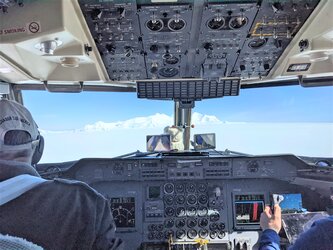CRISTAL prepares to sparkle
The structure of the first Copernicus Sentinel CRISTAL satellite is now ready to be equipped with the hardware that will allow it to function in orbit. Then, engineers will be able to install the advanced instruments that will provide ‘crystal clear’ insights into environmental changes in the world’s remote icy regions.
CRISTAL, which stands for Copernicus Polar Ice and Snow Topography Altimeter, will carry the first dual-frequency radar altimeter along with a microwave radiometer that will measure and monitor sea-ice thickness, overlying snow depth and ice-sheet elevation.

These data will support maritime operations in the polar oceans and contribute to a better understanding of climate processes. CRISTAL will also support applications related to coastal and inland waters, as well as providing observations to monitor ocean topography.
To ensure the long-term monitoring of Earth’s fragile polar regions, the mission comprises two identical satellites. CRISTAL-B will replace CRISTAL-A before the seven-year-plus in-orbit life of the first comes to an end.
Having recently passed its ‘critical design review’, which marks the end of the detailed design phase, CRISTAL-A is now moving into the next development phase, which includes the assembly and testing of the satellite.
ESA’s Kristof Gantois said, “This is a significant milestone in the mission’s development. We are thrilled to say that we have left the drawing board and that we are now proceeding with the assembly of the first CRISTAL satellite.
“It’s like a giant puzzle where all the equipment that has been designed and built over the past years by our various industrial partners is now coming together in Airbus’ facilities in Friedrichshafen in Germany.
“The satellite structure, which forms the skeleton of the satellite, is the first element we required. It now allows the satellite engineers at Airbus’ facilities in Friedrichshafen to install the various components and prepare for the arrival of its main instruments next year.”

The development of the satellite structure was carried out by APCO Technologies in Switzerland and the structure was delivered to Airbus at end of September for the integration phase.
The development of the altimeter, called IRIS, is progressing well at Thales Alenia Space in Toulouse, France, with flight hardware assembly and testing underway. It will be delivered to Airbus in the second half of 2025 to be integrated into the satellite.
The development of second instrument, the microwave radiometer, which is provided by NASA’s Jet Propulsion Laboratory, is also progressing well. With final system testing about to start, the instrument is on track to be delivered to Airbus next spring.
“Overall, the CRISTAL-A satellite is well on track towards achieving its qualification and acceptance review in June 2027 and to be ready to launch in second half of 2027. We would like to thank everyone involved in the mission for their hard work, which has allowed us to reach this point,” added Kristof Gantois.


Access the video














 Germany
Germany
 Austria
Austria
 Belgium
Belgium
 Denmark
Denmark
 Spain
Spain
 Estonia
Estonia
 Finland
Finland
 France
France
 Greece
Greece
 Hungary
Hungary
 Ireland
Ireland
 Italy
Italy
 Luxembourg
Luxembourg
 Norway
Norway
 The Netherlands
The Netherlands
 Poland
Poland
 Portugal
Portugal
 Czechia
Czechia
 Romania
Romania
 United Kingdom
United Kingdom
 Slovenia
Slovenia
 Sweden
Sweden
 Switzerland
Switzerland































